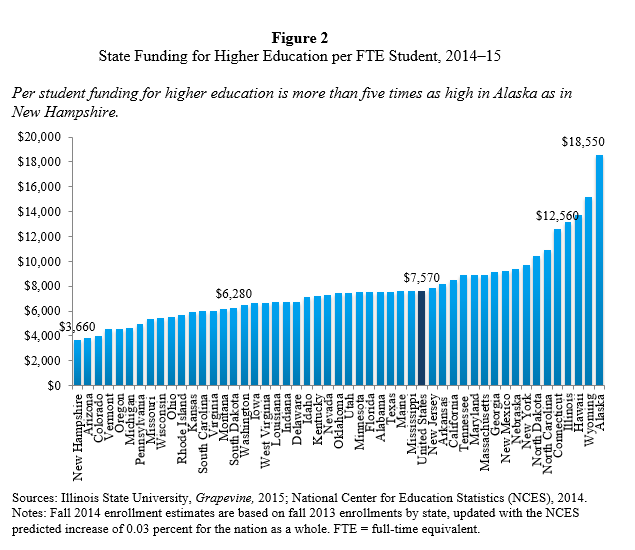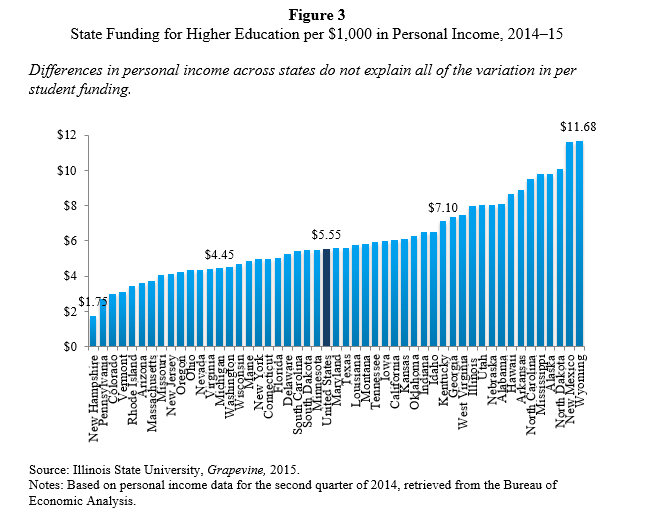Higher education costs vary state to state

Most students remain in their home states to take advantage of lower tuition at public colleges and universities, but those costs vary drastically from state to state.
A new report from the Urban Institute provides a snapshot of the higher education ecosystem, and shows that because public higher education is managed and partially funded by states, national averages hide considerable differences in what students actually pay across the country.
READ MORE SPECIAL COVERAGE:
"As policymakers and others consider these issues from a national perspective, they should review state-level patterns in tuition, funding, and enrollment rather than just national averages, which obscure important differences across states," wrote the primary authors of the report, Sandy Baum, a senior fellow in the Income and Benefits Policy Center at the Urban Institute, and Martha Johnson, a research assistant at the institute.
Read: 2014 Graduates Had Highest Student Loan Debt Ever
The report found that in the 2014-2015 academic year, tuition and fees for in-state students averaged $9,139 at public four-year colleges and universities, but there was significant variation between states. In 12 states, for example, the published price for state residents was less than $7,000, while it was above $11,000 in eight states.
In Wyoming, where median income closely hews to the national average, public four-year colleges and universities charged $4,646. But in New Hampshire, where median income for families is upward of $90,000, they charged $14,712.
Some potential reasons for the variations in pricing include differences in things like state funding per student, state costs of living and available public resources.
In the 2014-2015 school year, for example, state funding per student averaged $7,730, but ranged anywhere from $3,660 in New Hampshire to $18,550 in Alaska.
In wealthy states like Connecticut and New Jersey, lower-than-average funding relative to personal income tended to yield higher-than-average per-student funding in the 2014-2015 school year.
And New Hampshire, which doesn't have a sales or income tax, raises relatively less money than other states, while Wyoming's taxes on natural resources raise a disproportionate amount of revenue from out-of-state sources.
In addition, per-student measures of state funding for higher education are directly dependent on the number of college students enrolled.
ALSO: Biden Calls for 4 Years of Free College
According to the National Center for Education Statistics, only 7 percent of high school graduates in 2012 from Mississippi and 9 percent from Utah enrolled in colleges in other states. In contrast, 51 percent of those from Vermont and 46 percent from New Hampshire crossed state lines to begin college.
Finally, the availability of student financial aid is a big driver in the variation in costs across the country. Some states have generous grant programs, effectively lowering tuition for students at public in-state colleges and universities. Alternately, some states exclusively focus on reducing operating budgets, which reduces the tuition institutions must charge to cover ongoing costs.
Nationally, states allocated 13 percent of their 2013-2014 higher education funding to support student grant programs, while the other 87 percent went directly to support institutional operations. But in New Hampshire, the report notes, where per-student state funding for higher education is the lowest in the country, none of the money funded grant aid.
The Urban Institute on Monday also unveiled a separate report on the evolution of state funding for higher education, which tracks funding, enrollment and pricing changes over time.
More Special Coverage on Teaching for a Better Future:
The highest paying college major in every state
Is getting into an elite school the only way to define success?





